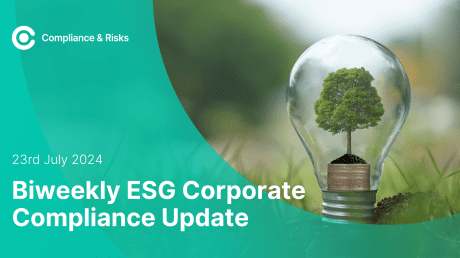
The Weekly Pulse: 12th – 16th December

What’s HOT in our Regulatory World
What are our clients looking at?
This week’s trending sources in C2P
- Washington (USA): Safer Products Restrictions and Reporting for Designated Priority Products, Revised Draft Rule, December 2022
- EU: Persistent Organic Pollutants (POPs), Regulation (EU) 2019/1021 – Amendment – (on hexachlorobenzene exemption in Annex I) Regulation (EU) 2022/2291
- Michigan (USA): Natural Resources and Environmental Protection Act, 1994 PA 451 – Proposed Amendment – (on polyfluoroalkyl substances (PFAS) in consumer products) House Bill 6536, 2022
What is our Content Team talking about?
Several Proposed Amendments to EU POPs Regulation – Dieudonné Ymedji
On 24 November 2022, the Competent Authorities for EU Persistent Organic Pollutants (POPs) Regulation 20… released five Draft Delegated Acts to amend Annex 1 of the EU POPs Regulation. The proposed texts among other things:
- update the specific exemptions of PFOA, its salts and PFOA-related compounds, and HBCDD,
- reduce the Unintentional Trace Contaminant (UTC) limit for PFOS and PFOS derivatives in substances, mixtures and articles to 1 mg/kg (0,0001%),
- introduce a newly UTC limit for PCB in substances, mixtures or articles.
Furthermore, in accordance with the Conference of the Parties (COP) meeting of the Stockholm Convention Decision SC-10/13 of June 2022 listing PFHxS, its salts and PFHxS-related compounds without specific exemptions to Annex A of the Convention, one of the proposed Acts, introduces a new entry under Annex I to restrict PFHxS in substances, mixtures and articles.
What are our Knowledge Partners talking about?
European Commission proposes extension of the transition periods foreseen in the Medical Device Regulation – Cooley
The implementation of Regulation (EU) 2017/745 on medical devices (“MDR”) was discussed on the second day of the meeting of the Employment, Social Policy, Health and Consumer Affairs Council (“EPSCO”) on Friday, 9 December, 2022. The European Commission proposes to extend the transition period currently foreseen in the MDR for devices certified in accordance with the Medical Device Directive (“MDD”) and the Active Implantable Medical Device Directive (“AIMDD”) (the “Directives”) through legislative amendment of the transitional provisions of the MDR. The extension of the transition period would be in the form of a staggered approach based on the risk classification of devices.
The transition period foreseen in the MDR provides that the deadline for recertification of medical devices in accordance with the MDR is 26 May 2024. A broad range of stakeholders, including the medtech industry, consider this timeline to be unattainable and have called on the European Commission to extend the recertification deadline. This extension would be based on the risk classification of devices and would mean that devices certified in accordance with the Directives will remain on the market in the EEA after the end of the currently applicable transition period.
The European Commission proposes the following targeted legislative amendments:
- Extension of the transitional provisions foreseen in the MDR based on the risk class of each device:
– 26 May 2027 for Class III and Class IIb medical devices
– 26 May 2028 for Class IIa and Class I medical devices
- Elimination of the sell-off date of 26 May 2025 for medical devices that are already available on the EEA market to prevent safe medical devices already on the market from being removed
The EU Commissioner for Health and Food Safety, Stella Kyriakides, noted that the proposed amendments would apply solely to medical devices that are safe for patients.
Following discussion with the Health Ministers of the EU Member States, Commissioner Kyriakides acknowledged the need for interim measures in relation to CE certificates of conformity previously issued for medical devices that have expired or will expire soon. The Commissioner noted that the European Commission will publish a Medical Device Coordination Group (“MDCG”) position paper in the coming days. The purpose of the position paper is to ensure a uniform approach to the application of market surveillance measures to bridge the gap between the expiry of certificates and the issuance of new certificates.
Besides the proposed legislative amendments, the European Commission intends to undertake a comprehensive evaluation of the MDR by May 2027. The purpose of the evaluation is to identify structural problems with the MDR and potential medium- and long-term solutions to these concerns. Moreover, the Commission intends to fund actions to support the implementation of the MDR under the EU4Health Programme starting in early 2023.
What are our clients asking about?
“Do you know if there are any plans for Germany to introduce a plastic packaging tax similar to the UK, Spain & Italy?
Answer by Freida Weuschner Gubbins
The big focus in Germany now is the creation of a disposable plastics fund, which is being referenced as a tax in certain regards. Details of which can be found in C2P under the title “Germany: Disposable Plastic Fund for Single-use Plastics, Draft Law, March 2022”.
Affected manufacturers will be required to pay into the fund with the rate dependent on the quantity of single-use plastic products they make available on the market. The payment is made by way of a special levy with a financing function. Public waste disposal authorities and other entitled legal entities will receive reimbursement for the costs of the services they provide from the disposable plastic fund.
Further details can be found on the Ministry website here https://www.bmuv.de/gesetz/referentenentwurf-des-gesetzes-zur-umsetzung-bestimmter-regelungen-der-eu-einwegkunststoffrichtlinie
Please note that the scope of the Draft is limited and does not apply to all plastic packaging. The following products are currently in scope of the Draft;
- Food containers,
- Bags and foil packaging made of flexible material, such as wrappers, with food content that is intended to be consumed directly from the bag or foil packaging and does not require any further preparation,
- Beverage containers with a capacity of up to 3.0 liters,
- Beverage cups including their caps and lids,
- Lightweight plastic carrier bags, i.e. plastic carrier bags, with a wall thickness of less than 50 microns, with or without a handle, offered to consumers at the point of sale of the goods or products,
- Wet wipes,
- balloons, excluding balloons for industrial or commercial purposes and applications that are not sold to consumers,
- Tobacco products.
Stay Updated On Global Regulations With The Weekly Pulse
This information is based on the most viewed regulations on C2P this month.
Sign up to get the latest compliance news delivered to your inbox weekly, for free!
The Pulse – Weekly Newsletter
Get the latest compliance news delivered straight to your inbox








